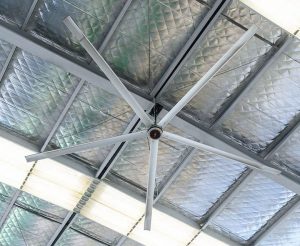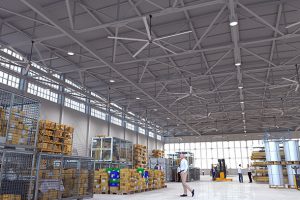Large halls, gyms, and plafond spaces often endure stuffy air and insufficient cooling, creating discomfort and reduced morale. This problem can lead to higher energy usage, worker fatigue, and even lower productivity. Thankfully, by choosing the ventilateur de plafond droit—whether 3 lames ou 5 blade—you can elevate air quality, déplacer l'air more efficiently, and keep everyone comfortable.
UN 3 blade ceiling fan generally spins faster and can offer direct, focused airflow, while a 5 blade ceiling fan disperses air more gently and quietly. Both ventilateur de plafond styles perform well if sized properly for your space. The number of blades influences airflow patterns, noise levels, and aesthetics. Ultimately, each blade ceiling fan design can deliver excellent cooling results when correctly chosen for its environment.
When deciding on a ventilateur de plafond, many people weigh the difference between 3 et 5-blade ceiling fan setups. Each approach offers distinct benefits related to cooling power, acoustics, and aesthetics. From an engineering standpoint, a 3 lames configuration generally features fewer surfaces in contact with the air, which can affect how the fan moves air. Meanwhile, a 5 blade setup includes more pale de ventilateur surfaces rotating, potentially influencing noise levels, flux d'air, and overall style.
UN 3 blade fan tends to achieve a higher speed with fewer surfaces. In contrast, a 5-blade ceiling fan often runs somewhat slower yet can create a broader, gentler breeze. Because each lame arrangement interacts with the plafond environment differently, picking the correct type de ventilateur for your situation is key.
Points of Distinction

5-blade HVLS FANS
There’s a common perception that a fan with more blades automatically moves more air. However, the real difference depends on multiple factors such as motor power, blade pitch, and the overall ceiling fan design. UN 5 blade ceiling fan might produce a wider path of airflow at a lower speed, while a 3 lames might spin faster to deliver strong bursts of coolness.
If your goal is to déplacer plus d'air across a big space, a fan with fewer blades can actually do quite well, provided it has a robust motor and optimal lame shape. On the flip side, 5 blade fans might be quieter and more visually balanced, which can suit certain upscale or acoustic-sensitive environments. Ultimately, it’s a balancing act: fewer blades plus a strong motor might yield the same or better flux d'air as multiple blades with a weaker motor.
Some suggest that ceiling fan with more blades means a stronger breeze. In reality, the blade count is just one factor among many. Fans with fewer blades can operate at higher RPM with less friction, pushing an equal or greater volume d'air. If the fan is also designed with a high-quality moteur de ventilateur de plafond, it can easily keep up or surpass the performance of a 5-blade device.
(3 Blade vs 5 Blade Air Movement)
| Aspect | 3 Blade | 5 Blade |
|---|---|---|
| Vitesse | Higher RPM potential | Slightly lower RPM |
| Bruit | Could be louder at top speed | Typically quieter due to more surfaces |
| Flux d'air (potential) | Quick bursts, targeted | Larger, more diffused coverage |
| Design | Minimal, modern look | Traditional, symmetrical style |
Le blade material dans un ventilateur de plafond significantly shapes its performance, durability, and noise level. Common materials include wood, metal, and plastic. Each choice has pros and cons, especially considering factors like humidity levels, temperature, or dust in an environment.
In many industrial settings, metal is the go-to lame material. It can handle heavy usage, handle moderate impacts, and facilitate strong circulation d'air. Yet metal might be noisier if the motor or the entire system isn’t well-balanced. Still, if you want a fan that can run for years with minimal fuss, a metal-bladed design is tough to beat.
Wood ou plastic fan blades frequently appear in home ceiling fans, as they’re lighter, quieter, and often more decorative. For “blade ceiling fan” designs in living rooms or smaller offices, these materials keep noise and vibration to a minimum. Plastic can also resist moisture, making it suitable for damp areas.
If you need a ventilateur de plafond for a greenhouse or a commercial kitchen, choose materials that won’t warp under moisture or temperature changes. Typically, metal or specialized polymer composites hold up better. For example, in a residential ceiling fan context, plastic might suffice—but for large industrial fans, heavier-duty alloys might be necessary.

ventilateurs de plafond HVLS pour serre
Le number of blades can change how well a ventilateur de plafond can move air, how quietly it runs, and how it looks. That said, a fan’s performance isn’t solely about blade count—blade pitch, angle of the blade, motor torque, and the surface area of the blade also matter.
UN 3 blade fan usually leads to less drag, letting the fan spin faster and produce strong bursts of wind. This design can be particularly beneficial for industrial or commercial floors where you want quick mouvement de l'air. Having fewer blades can reduce the chance of noise from overlapping airflow paths.
UN 5-blade ceiling fan may spread out the circulation d'air more evenly at slightly lower speeds. Some prefer the more symmetrical look of a 5-blade arrangement, especially in upscale or home ceiling fans setups. This can also be quieter, as the additional surfaces share the load, leading to fewer abrupt changes in velocity.
A mid-sized community center installed two different fans in separate halls: one 3 lames design for the sports court, and a 5 blade design for a reception area. Observations revealed the 3-blade model gave strong, direct breezes—ideal for sweaty athletes—whereas the 5-blade design’s gentler airflow was better in quieter lounge spaces.
When it comes to raw circulation d'air, the difference between 3 and 5 blades depends on fan diameter, motor efficiency, and the chosen speed. However, fans with 3 lames setups can spin rapidly, easily cutting through air with minimal drag, thus effectively cooling large spaces.
It’s not always about how many blades but rather how the design fosters maximum contact with air at the correct angles. In big open spaces—like gyms, retail stores, or factories—3-blade fans are often favored for a more powerful breeze at moderate speed. Meanwhile, a 5-blade ceiling fan might produce a broader yet slower breeze.
Interestingly, some 3-blade and 5-blade ceiling fans share identical motor power, yet produce different “feels” in occupant comfort. If you prefer a direct, robust wind, a 3-blade ceiling might be the best. If you want calmer, more distributed cooling, a 5 blade option can be beneficial.
We see 4 blade ceiling fans, five blade versions, even some with six or more blades in certain industrial designs. So how do 3-blade fans stack up against these “many blades” or “increased number of blades” approaches?
UN fan with more blades might revolve more slowly for the same airflow, potentially leading to quieter operation. On the flip side, a 3 lames device typically runs faster, creating a more intense breeze with less mechanical complexity. More blades can also add weight, meaning the moteur de ventilateur must work harder or run at lower RPM to offset the load.
Some believe a 5-blade ceiling fan might “perform better” simply due to more surfaces pushing air. However, if the motor power or blade design is suboptimal, those extra blades can hamper efficiency. Meanwhile, a well-engineered 3 lames might cut through air effectively, delivering strong breezes at lower power usage. The real key is synergy between motor, blade pitch, and overall ventilateur de plafond size.
An efficient ventilateur de plafond can reduce reliance on air conditioning, leading to économies d'énergie. Understanding the factors that influence ceiling fan efficiency helps you pick the right device for your space.
Blade design is about more than just how many blades you have. The shape, curvature, thickness, and distribution of material all decide how well your ventilateur de plafond peut déplacer plus d'air at minimal energy cost. Some fans are built with gently curved edges, while others might have sharper angles to catch air aggressively.
blade tilt ou angle of the blade helps produce consistent airflow. If the angle is too shallow, the fan might generate less air movement, especially at lower speeds. If it’s too steep, the motor might experience undue stress, potentially leading to a fan is also scenario where efficiency plummets. The sweet spot is typically between 10–15 degrees, but certain designs may differ.
A well-conceived blade geometry can reduce noise and let the fan operate smoothly for many years. By factoring in ceiling fan design specifics—like blade pitch and shape—manufacturers can produce fans that run quietly, maintain longevity, and keep spaces comfortable.
While we often discuss ventilateurs industriels in large manufacturing plants, a well-chosen fan can also benefit commercial offices, school gyms, or even home ceiling fans. How do you ensure you’re choosing the right ceiling fan?
A high ceiling might call for a 3 blade ceiling fan with longer blade span to push air downward effectively. Meanwhile, smaller rooms do well with shorter diameters, possibly a 5-blade or 4-blade design that fits local code and occupant comfort.
Make sure the moteur de ventilateur de plafond can handle the chosen lame arrangement. If the motor is too weak for a large 5-blade assembly, performance suffers. Conversely, a robust motor matched with fewer blades might run at half capacity, offering excellent coverage with minimal noise.

Grands ventilateurs industriels
Now that we’ve explored 3 lames contre. 5 blade setups, let’s revisit the crucial question: Are 3 or 5 blade ceiling fans better? The real answer is that both can excel in different contexts, depending on your space, noise sensitivity, aesthetics, and mouvement de l'air requirements.
Que ce soit un 3 blade vs. 5 blade scenario, you can’t go wrong if you consider blade pitch, blade material, motor specs, and your specific environment. If you run a big space like a factory, a 3 lames approach might be perfect for high-velocity cooling. If it’s a quieter or more style-focused location, a 5-blade ceiling fan can feel luxurious. Above all, ensure the fan is also sized properly, as factors that influence ceiling fan efficiency matter as much as the number of blades.
Whether you prefer a 3-blade ceiling fan ou un 5-blade ceiling fan, each style has unique perks that can déplacer l'air efficiently and keep large spaces comfortable. At HVLS Fans Manufacturing, we help you select the lame arrangement, motor strength, and overall plafond setup that fits your environment. Ultimately, 3 lames ou 5 blade design can both excel—choisir based on your facility’s size, noise requirements, and brand image.

Salut, je suis Michael Danielsson, PDG de Vindus Fans, avec plus de 15 ans d'expérience dans le secteur de l'ingénierie et de la conception. Je suis ici pour partager ce que j'ai appris. Si vous avez des questions, n'hésitez pas à me contacter à tout moment. Grandissons ensemble !